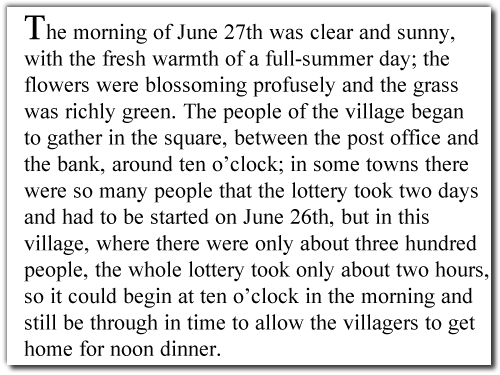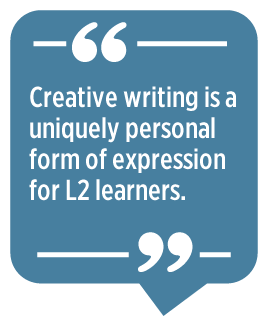
Creative writing, or writing that uses language in playful, surprising, or creative ways (Tin, 2011), has been shown to increase second language (L2) learners’ motivation (Viete, 2011), enhance their L2 acquisition (Crystal, 1998), and develop their lexical, grammatical, and discursive knowledge (Kırkgöz, 2014). Importantly, then, though many (if not most) English as a second language (ESL) writing classes focus solely on communicative tasks, integrating creative tasks into a writing curriculum focused on communicative competence can enhance standard academic literacy practices.
Additionally, teaching creative writing to L2 learners is not only useful for their language development, but it is also an ethical practice because these types of creative tasks celebrate diverse voices using English in interesting and surprising ways (Viete, 2011). Creative writing can be integrated into K–12, university, and intensive English program or English for academic purposes teaching contexts as
- a standalone elective course;
- part of process-oriented writing sequences;
- warm-up or cool-down activities;
- a way to foster a sense of community in the classroom; and
- a way to incorporate something new, fresh, and fun into the classroom.
Begin With Introducing Poetry
Poetry is an accessible choice to begin using creative writing tasks in the classroom. Poetry can work especially well with low intermediate to intermediate L2 learners who are still developing fluency. Kırkgöz (2014) suggested using Bouman’s (1983) “writing-using model,” in which three steps are utilized:
Step 1: The poem is made “comprehensible” to learners.
Step 2: Learners explore the poem, which could include discovering the poem’s rhythm, rhyme, figurative language, grammar, and emotional impact.
Step 3: Learners create their own poem inspired by the model.
This model is easily adapted for learners of all ages and can be used to facilitate the process of introducing learners to new types of poems and new ways in which they can use the English language to create meaning. Poets who work well with a variety of learners include Langston Hughes, Billy Collins, Maya Angelou, and Naomi Shihab Nye.
1. Acrostic Poems
One effective way easily to integrate poetry into an existing ESL curriculum is asking learners to create an acrostic poem. An acrostic poem is when one word is written vertically, and the learner supplies a word that begins with each first letter of the selected word. For example, the instructor might ask their class to write an acrostic poem using the word learning and have students write a sentence for each letter which describes their own process and experience of learning a second or foreign language.

Another way to use acrostic poems is for learners to create a poem using their name as the vertical word, and using adjectives to describe themselves. This activity works particularly well as an icebreaker at the beginning of a course; students can share their acrostic poem with their instructor and classmates to introduce themselves in an engaging way. Following is an example:
Merry
Energetic
Gracious
Affectionate
Nice
2. Simile Poems
A simile poem is another quick and effective way to foster learners’ creativity and encourage lexical development. A simile is the comparison of two things using the word like or as. For example, you might provide learners with the simile sentence frame, “Learning English is like…” Learners could then respond with gerund clauses like “climbing a mountain” or “traveling to a new country.” In turn, learners’ responses could help them differentiate between gerunds and participles.
3. Haikus
A haiku is a three-line poem in which there is a set number of syllables for each line (five syllables for the first line, seven syllables for the second line, and five syllables for the third line). Haikus can help learners practice writing mindfully and concisely, as haikus require that one utilizes words economically. Moreover, writing a haiku can also help learners better appreciate how the choice of a single word can create meaning.
Use Narrative Activities for More Proficient Learners
Telling their own personal stories can aid learners’ metacognitive and linguistic development as well as help create positive affect and increase motivation (Nicholas, Rossiter, & Abbott, 2011). Narrative activities are well-suited for more proficient English learners because of their increased length and difficulty level, but the following ideas for activities are easily adapted for different teaching contexts and student interests.
1. Short Stories
Asking learners to create short stories can activate their imaginations and encourage interesting lexical choices. You could provide the first line or the first paragraph of an existing short story, and ask the learners to finish the story. Then, they could compare and contrast their story with the original, and discuss the choices they made. Some good story beginnings to use in this way include “The Lottery,” by Shirley Jackson or “The Gift of the Magi,” by O. Henry.

Figure 1. Opening paragraph of “The Lottery,” by Shirley Jackson (2019).

Figure 2. Opening paragraph of “The Gift of the Magi,” by O. Henry (2005).
2. Personal Narratives
Creative writing activities can include asking learners to write nonfiction as well as fiction. A personal narrative tells a story based around a significant moment in the learner’s life. One way to scaffold this activity is to begin by asking learners to read models of personal narratives before writing their own. I have previously used the following narratives with successful results and positive learner responses:
- “Newcomers in a Troubled Land” and “Mint Snowball” (both from the collection Never in a Hurry, Naomi Shihab Nye)
- “Me Talk Pretty One Day” (David Sedaris)
- “Mother Tongue” and “Fish Cheeks” (both from The Opposite of Fate, Amy Tan)
Once learners have had the opportunity to explore models of personal narratives, they should be guided to choose an important moment of their life which they would like to explore. If learners are feeling stuck, asking them to look at selfies they’ve taken and narrate the surroundings using the five senses and descriptive language can be a good place to begin. This can help learners practice not only descriptive language, but also create imagery and use other literary devices.

3. Literacy Narratives
A literacy narrative narrates the process of learning how to read and write (either in the learner’s first language or L2). This exercise is a valuable way to ask learners to reflect on their own literacy practices in order to set goals for improvement in both reading and writing.
First, you might ask learners to think about the most formative moments in their English language education, and then ask them to describe how one of those moments made them the learner they are today. Another option would be to ask learners to define what they think it means to be literate in the English language as an L2 learner. Using excerpts of Richard Rodriguez’s Hunger of Memory can help learners understand this type of task.
A literacy narrative works particularly well as the first assignment in a process-based writing sequence; additionally, a literacy narrative can widen the learner’s understanding of targeting a specific audience, and the location of their writerly self.
Create a Collaborative Community of Writers
Creative writing is a uniquely personal form of expression for L2 learners, and indeed, for all writers. Because of this, it is essential to create a community in which learners feel safe to read and share their work with one another. One way to create such a community is for you, as the instructor, to fully participate in the course as a writer. For example, before asking learners to read or share their own work, you can read your work out loud as a model of how to engage with an audience.
Another way to create a collaborative community of creative writers is to host an event (to which other members of the learners’ community are invited) at which learners read their work out loud; this way, learners are able to share their work with a wider audience and offer positive feedback and reinforcement to one another. Finally, if resources allow, “publishing” a collection of learner writing, whether in print or online, is a wonderful way to demonstrate the idea of writing for a wider audience.
Prepare for Challenges Ahead of Time
Some L2 learners may be resistant to engage in creative writing tasks, particularly if they have spent previous courses focusing only on academic writing. Thus, it is crucial to create student buy-in by explaining how and why creative writing activities can help learners in their English language proficiency.
Finally, although creative writing activities can be used with all ages, it is also important to remember that creative writing asks the writer to be vulnerable and open in a way that might be new or scary for younger or beginning learners. It is crucial to be aware of what topics may or may not be appropriate to introduce, and to provide support, such as guided topic selection.
References
Crystal, D. (1998). Language play. The University of Chicago Press.
Henry, O. (2005). The gift of the magi. Project Gutenberg. https://www.gutenberg.org/files/7256/7256-h/7256-h.htm
Jackson, S. (2019). The lottery and other stories. Farrar, Straus and Giroux.
Kırkgöz, Y. (2014). Exploring poems to promote language learners’ creative writing.Procedia –Social and Behavioral Sciences, 158, 394–401. http://doi.org/10.1016/j.sbspro.2014.12.106
Nicholas, B. J., Rossiter, M. J., & Abbott, M. L. (2011). The power of story in the ESL classroom. The Canadian Modern Language Review, 67(2), 247–268. http://doi.org/10.3138/cmlr.67.2.247
Tin, T. B. (2011). Language creativity and co-emergence of form and meaning in creative writing tasks. Applied Linguistics, 32(2), 215–235. http://doi.org/10.1093/applin/amq050
Viete, R. (2011). Crafting new possibilities for self: The ethics of teaching creative writing in EFL. In P. Ha & B. Baurain (Eds.), Voices, identities, negotiations, and conflicts: Writing academic English across cultures (pp. 3–21). Emerald Group.
|
Download this article (PDF) |
Megan Hansen Connolly is a lecturer in the Department of Second Language Studies at Indiana University in Bloomington, Indiana. She previously taught English as a foreign language at Chiang Mai University in Chiang Mai, Thailand, and received an MA in English from Boston College. Her research interests include second language reading and writing and ESL curriculum development.
| Next Article |
